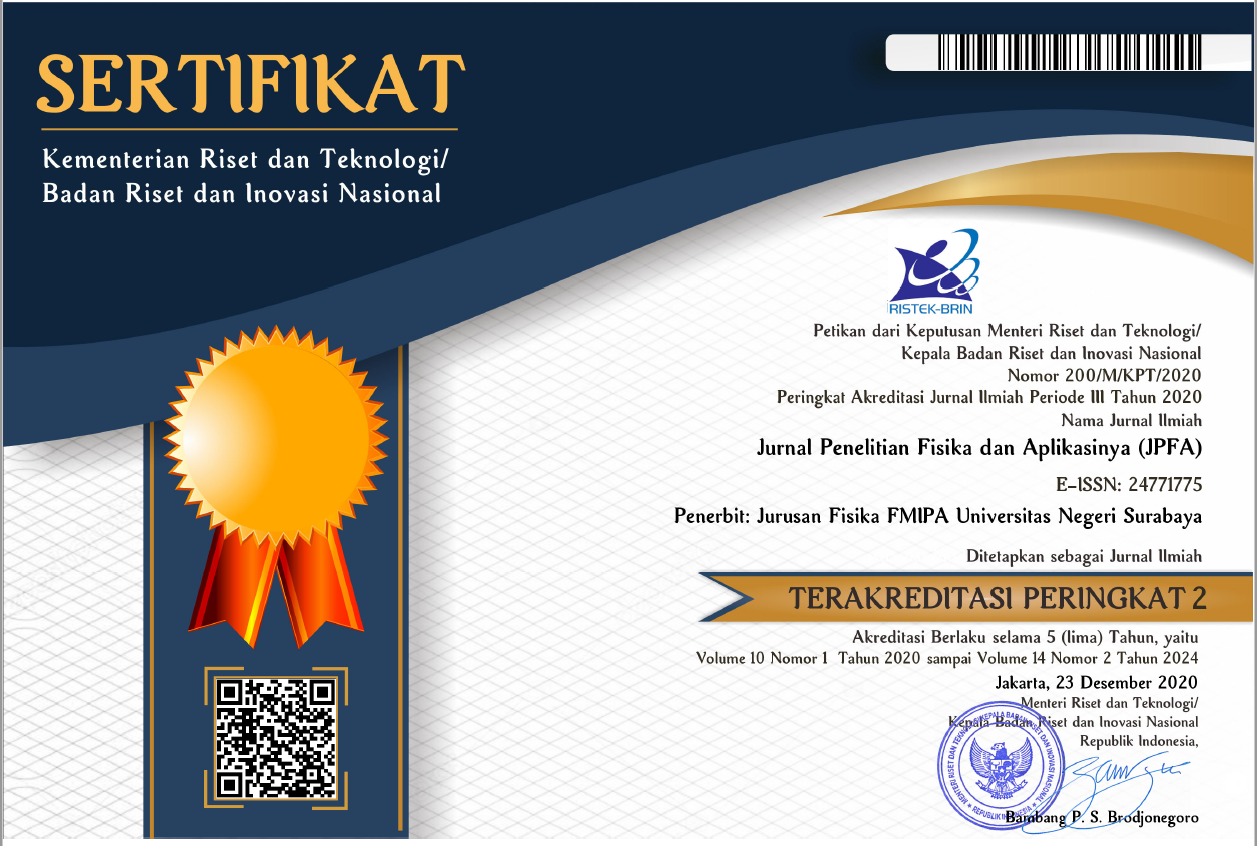High Preferred Orientation on c-axis of ZnO:GO Crystal Film Synthesized Under Electric Field
DOI:
https://doi.org/10.26740/jpfa.v13n2.p146-159Keywords:
ZnO submicron-rods, graphene oxide (GO), self-assembly, Sol-gel, external electric field, hexagonal wurtzite, c-axis preferred orientationAbstract
ZnO nanostructures show a wide range of applications as active materials in optoelectronic devices. The unique structures in 1-dimensional (1D) in combination with other potential materials (such as graphene-based) can increase several device performances. This research aims to observe the influence of an additional electric field (induced by different voltages of ±1 kV) during the growing process of the zinc oxide (ZnO): graphene oxide (GO) crystal. The ZnO:GO layers were prepared via the self-assembly method in 2 steps; the first was seed layer preparation by dip coating technique using Zn (CH3COO)2.2H2O and 0.5 (wt%) of AlCl3 as precursor and dopant, respectively. Secondly, growing ZnO rods using Zn (NO3)2·6H2O as precursor, 0.5 (wt%) GO (dispersed in water) as dopant materials, and hexamethylenetetramine (HMTA) as complexing agent. Applying an external field during self-assembly accelerated the ZnO hexagonal wurtzite crystal formation in a vertical growth direction, increasing the aspect ratio (L/d) of ZnO:GO rods. The direction of the applied external field affected the structure and morphology of the ZnO rods, which relates to ions and seed layer surface polarity during the synthesis process. The addition of an external field during the growing process induced the orderly alignment of ZnO rods, controlling growth perpendicular to the basal plane. This research has a significant scientific impact, elucidating the methods to control the 1D morphology of the ZnO growing process, which is closely related to the surface polarity properties of a material.
References
Borysiewicz MA. ZnO as a Functional Material, A Review. Crystals. 2019; 9(10): 1-29. DOI: https://doi.org/10.3390/cryst9100505
Singh AK and Singh SK. Optical Properties of ZnO. Metal Oxides: Nanostructured Zinc Oxide. Elsevier; 2021; 189-208. DOI: https://doi.org/10.1016/B978-0-12-818900-9.00014-0
Nahhas AM. Recent Advances of ZnO Based Nanowires and Nanorods Devices. American Journal of Nanomaterials. 2018; 6(1): 15-23. DOI: https://doi.org/10.12691/ajn-6-1-2
Basher MK, Shah Riyadh SM, Hossain MK., Hassan M, Akand Rafiq MdA, Amir Al-Zumahi SM, Abdul Matin Md, Das N, Nur-E-Alam M. Development of Zinc-Oxide Nanorods on Chemically Etched Zinc Plates Suitable for High-Efficiency Photovoltaic Solar Cell. Optical and Quantum Electronics. 2023; 55: 322. DOI: https://doi.org/10.1007/s11082-022-04474-1
Zhou J, Qiao Q, Tan Y, Wu C, Hu J, Qiu X, Wu S, Zheng J, Zhang C, Xuan Yu, Xiaoming Yu, and Li Z. The Improvement of Polymer Detector Based on 1D-ZnO Nanorod Arrays/0D-ZnO Quantum Dots Composite Film. Optical Material. 2023; 142: 114086. DOI: https://doi.org/10.1016/j.optmat.2023.114086
Mishra S, Przezdziecka E, Wozniak W, Adhikari A, Jakiela R, Paszkowicz W, Sulich A, Ozga M, Kopalko K, Guziewicz E. Structural Properties of Thin ZnO Films Deposited by ALD under O-Rich and Zn-Rich Growth Conditions and Their Relationship with Electrical Parameters. Materials. 2021; 14(14): 4048. DOI: https://doi.org/10.3390/ma14144048
Anh Thi Le, Ahmadipour M, Swee-Yong Pung, A Review on ZnO-based Piezoelectric Nanogenerators: Synthesis, Characterization Techniques, Performance Enhancement and Applications. Journal of Alloy Compounds. 2020; 156172. DOI: https://doi.org/10.1016/j.jallcom.2020.156172
Ahmad T, Pandey V, Husain MS, Adiba, Munjal S. Structural and Spectroscopic Analysis of Pure Phase Hexagonal Wurtzite ZnO Nanoparticles Synthesized by Sol-gel. Materials Today: Proceedings. 2022; 49: 1694-1697. DOI: https://doi.org/10.1016/j.matpr.2021.07.456
Tripathi P, Nayak SK, Tripathi GS. Electronic Structure Theory of Strained Wurtzite ZnO. Physica Scripta. 2020; 95(12): 125801. DOI: https://doi.org/10.1088/1402-4896/abc118
Consonni V, and Lord AM. Polarity in ZnO Nanowires: A Critical Issues Piezotronics and Piezoelectric Devices. Nano Energy. 2021; 83: 105789. DOI: https://doi.org/10.1016/j.nanoen.2021.105789
Aprilia A, Fernando H, Bahtiar A, Safriani L, Hidayat R. Influences of Al Dopant Atoms to the Structure and Morphology of Al Doped ZnO Nanorod Thin Film. Journal of Physic Conference Series. 2018; 1080: 012009. DOI: https://doi.org/10.1088/1742-6596/1080/1/012009
Avc? B, Caglar Y, and Caglar M. Controlling of Surface Morphology of ZnO Nanopowders via Precursor Material and Al Doping. Materials Science in Semiconductor Processing. 2019; 99: 149-158. DOI: https://doi.org/10.1016/j.mssp.2019.04.028
Rabia A, Riaz A, Naveed A, Mubarik, and Ehtesham F. Effect of Structure Modifying Agents on the Structural, Morphological and Optical Features of Hydrothermally Grown ZnO. Journal of Nanoscience and Nanotechnology. 2020; 20(5): 3265-3273. DOI: https://doi.org/10.1166/jnn.2020.17389
Wang J, Chen R, Xiang L, Komarneni S. Synthesis, Properties and Applications of ZnO Nanomaterials with Oxygen Vacancies: A Review. Ceramics International. 2018; 44(7): 7357-7377. DOI: https://doi.org/10.1016/j.ceramint.2018.02.013
Liu WM, Li J, and Zhang HY. Reduced Graphene Oxide Modified Zinc Oxide Composites Synergistic Photocatalytic Activity under Visible Light Irradiation. Optik, 2020; 207. DOI: https://doi.org/10.1016/j.ijleo.2019.163778
Shahzad S, Javed S, and Usman M. A Review on Synthesis and Optoelectronic Applications of Nanostructured ZnO. Frontiers in Materials. 2021; 8. DOI: https://doi.org/10.3389/fmats.2021.613825
Ching KL, Li G, Ho YL, and Kwok HS. The Role of Polarity and Surface Energy in the Growth Mechanism of ZnO from Nanorods to Nanotubes. Crystall Engineering Comm 2016; 18(5): 2219-2224. DOI: https://doi:10.1039/C5CE02164B.
Utami NP, Rahmawati AN, Bahtiar A, Suryaningsih S, and Aprilia A. Synthesis of ZnO Submicron-Rods by Self Assembly Method and Its Properties. AIP Conference Proceeding. 2023; 2604; 020024. DOI: https://doi.org/10.1063/5.0114479.
Molefe FV, Mofokeng SJ, Khenfouch M, Achehboune M, Dhlamini MS, Mothudi BM, Koao LF. The Effect of Zn2+ on the Anion Vacancies in ZnO Thin-films Grown using Chemical Bath Deposition. Journal of Physics Conference Series. 2019; 1292: 012016 DOI: https://doi.org/10.1088/1742-6596/1292/1/012016
Song Y, Zhang S, Zhang C, Yang Y, and Lv K. Raman Spectra and Microstructure of Zinc Oxide Irradiated with Swift Heavy Ion. Crystals. 2019; 9(8): 395. DOI: https://doi.org/10.3390/cryst9080395.
Shukla V and Patel AJ. Effect of Doping Concentration on Optical and Electrical Properties of Intrinsic N-type ZnO (i-ZnO) and (Cu, Na and K) Doped p-type ZnO Thin Films Grown by Chemical Bath Deposition Method. Nanosystems: Physics, Chemistry, Mathematics. 2020; 11(4): 391-400. DOI: https://doi.org/10.17586/2220-8054-2020-11-4-391-400.
Ahmed G, Hanif M, Mahmood K, Yao R, Ning H, Jiao D, Wu M, Khan J, and Liu Z. Lattice Defects of ZnO and Hybrids with GO: Characterization, EPR and Optoelectronic Properties. AIP Advances. 2018; 8(2): 025218. DOI: https://doi.org/10.1063/1.5011356
Akbari E, Akbari I, and Ebrahimi M. sp2/sp3 Bonding Ratio Dependence of the Band-gap in Graphene Oxide. The European Physical Journal B. 2019; 92: 1-6. DOI: https://doi.org/10.1140/epjb/e2019-90675-y
Mustapha S, Ndamitso MM, Abdulkareem AS, Tijani JO, Shuaib DT, Mohammed AK, and Sumaila A. Comparative Study of Crystallite Size Using Williamson-Hall and Debye-Scherrer Plots for ZnO Nanoparticles. Advances in Natural Science: Nanoscience and Nanotechnology. 2019; 10(4): 045013. DOI: https//doi.org/10.1088/2043-6254/ab52f7
Abdulrahman AF, Ahmed SM, Hamad SM, Almessiere MA, Ahmed NM, and Sajadi SM. Effect of Different pH Values on Growth Solutions for the ZnO Nanostructures. Chinese Journal of Physics. 2021; 71: 175-189. DOI: https//doi.org/10.1016/j.cjph.2021.02.013
Ghosh S, Gosh A, Pramanik Z, Kuiri KP, Sen R, and Neogi SK. Synthesis of ZnO Nanoparticles by Co-precipitation Technique and Characterize the Structural and Optical Properties of These Nanoparticles. Journal of Physics Conference Series. 2022. 2349; 012014. DOI: https//doi.org/ 10.1088/1742-6596/2349/1/012014
Hebbar RS, Isloor A, and Ismail AF. Contact Angle Measurement. Membrane Characterization. (2017): 219-255. DOI: https//doi.org/ 10.1016/b978-0-444-63776-5.00012-7
Ellinas K, Dimitrakellis P, Sarkiris P, and Gogolides E. A Review of Fabrication Methods, Properties and Applications of Superhydrophobic Metals. Processes. 2021; 9(4): 666. DOI: https://doi.org/10.3390/pr9040666
Downloads
Published
How to Cite
Issue
Section
License
Copyright (c) 2023 Jurnal Penelitian Fisika dan Aplikasinya (JPFA)

This work is licensed under a Creative Commons Attribution-NonCommercial 4.0 International License.
Author(s) who wish to publish with this journal should agree to the following terms:
- Author(s) retain copyright and grant the journal right of first publication with the work simultaneously licensed under a Creative Commons Attribution-Non Commercial 4.0 License (CC BY-NC) that allows others to share the work with an acknowledgement of the work's authorship and initial publication in this journal for noncommercial purposes.
- Author(s) are able to enter into separate, additional contractual arrangements for the non-exclusive distribution of the journal's published version of the work (e.g., post it to an institutional repository or publish it in a book), with an acknowledgement of its initial publication in this journal.
The publisher publish and distribute the Article with the copyright notice to the JPFA with the article license CC-BY-NC 4.0.
 Abstract views: 249
,
Abstract views: 249
, PDF Downloads: 257
PDF Downloads: 257








